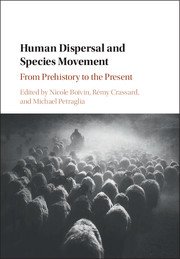Book contents
- Frontmatter
- Contents
- List of text boxes
- List of figures
- List of tables
- List of contributors
- Preface
- I Introduction
- II Origins: Species Movements in the Pleistocene
- III Across the water: Species movements by Coast and Sea
- IV Complexity: Species Movements in the Holocene
- 9 Dispersals, connectivity and indigeneity in Arabian prehistory
- 10 Reconstructing migration trajectories using ancient DNA
- 11 Out of the Fertile Crescent: The dispersal of domestic livestock through Europe and Africa
- 12 Adapting crops, landscapes, and food choices: Patterns in the dispersal of domesticated plants across Eurasia
- 13 Tracing the initial diffusion of maize in North America
- 14 Proto-globalisation and biotic exchange in the Old World
- V Invasion: The Movement of Invasive and Disease Species
- Index
- Plate section
- References
12 - Adapting crops, landscapes, and food choices: Patterns in the dispersal of domesticated plants across Eurasia
from IV - Complexity: Species Movements in the Holocene
Published online by Cambridge University Press: 04 May 2017
- Frontmatter
- Contents
- List of text boxes
- List of figures
- List of tables
- List of contributors
- Preface
- I Introduction
- II Origins: Species Movements in the Pleistocene
- III Across the water: Species movements by Coast and Sea
- IV Complexity: Species Movements in the Holocene
- 9 Dispersals, connectivity and indigeneity in Arabian prehistory
- 10 Reconstructing migration trajectories using ancient DNA
- 11 Out of the Fertile Crescent: The dispersal of domestic livestock through Europe and Africa
- 12 Adapting crops, landscapes, and food choices: Patterns in the dispersal of domesticated plants across Eurasia
- 13 Tracing the initial diffusion of maize in North America
- 14 Proto-globalisation and biotic exchange in the Old World
- V Invasion: The Movement of Invasive and Disease Species
- Index
- Plate section
- References
Summary
Abstract
After the domestication of plants and animals, the subsequent spread of agriculture represented a process of adaptation of both species and landscapes. Crop species moved beyond their original ecological limits, and their range expansion, when successful, was generally the result of adaptive post-domestication genetic changes on the part of the plants, human-induced changes in agricultural landscapes, and the dynamics of cultural food choice. This chapter explores the patterns by which agriculture became established as a consequence of the diffusion of domesticated plants (and sometimes people), as well as the ways in which agricultural systems were gradually transformed through the diversification of crop packages. Comparisons from across Eurasia are drawn to identify general patterns in crop dispersal, with three categories playing the largest role in the diffusion of grain-based agriculture. These agricultural systems are discussed and their modes of diffusion, stories of collapse, and examples of new adaptations on the part of the crops and agricultural systems detailed.
Keywords: Agriculture, Neolithic, domestication, cuisine, archaeobotany
INTRODUCTION
Agriculture is widely regarded as one of the key changes in ecological and economic systems in the history of Homo sapiens (Diamond 2002; Bellwood 2005; Barker 2006; Smith and Zeder 2013). There is no doubt that agriculture set in motion increases in human population density and the transformation of environments, from biomes to ‘anthromes’ (sensu Ellis 2011). Over the long-term, land-use intensified primarily through agriculture, supporting denser populations and increasing regional carrying capacity by supporting more people from less land (Ellis et al. 2013). In this regard there should be little surprise that anthropologists and archaeologists have expended considerable effort on the study of agricultural origins, although more often than not this has focused on the search for pristine origins – those relatively few instances in which hunter-gatherers became farmers by domesticating plants and animals that were wild in their environment. As archaeological research and biological studies of wild progenitors have progressed, the number of recognized centres of origins has expanded from half a dozen or less, to close to ten, and perhaps even twenty or more (Fuller 2010; Larson et al. 2014). Nevertheless, it is undeniable that for the majority of the planet, agriculture was introduced from elsewhere and was based on plants and animals introduced as domesticates.
- Type
- Chapter
- Information
- Human Dispersal and Species MovementFrom Prehistory to the Present, pp. 304 - 331Publisher: Cambridge University PressPrint publication year: 2017
References
- 24
- Cited by



